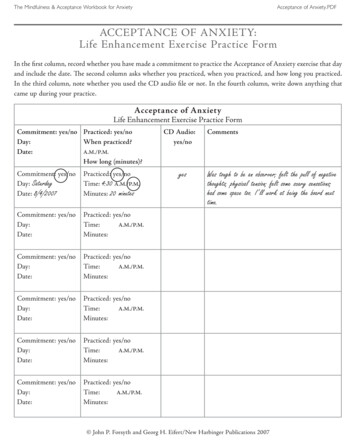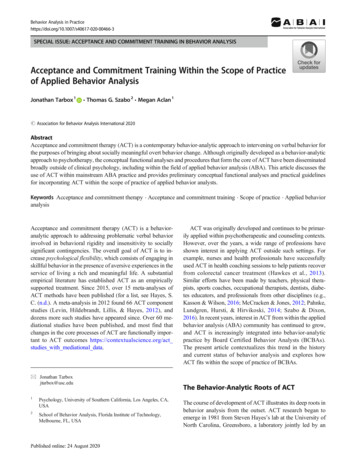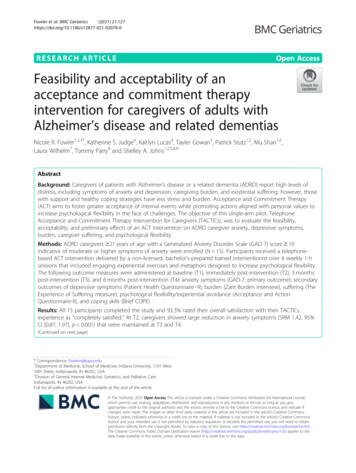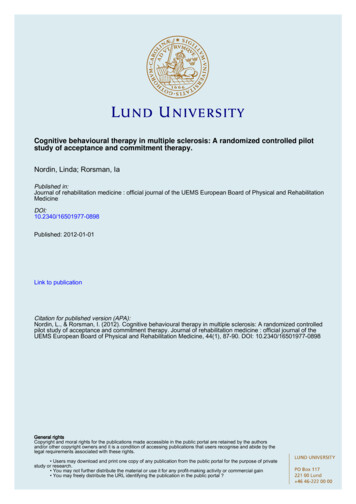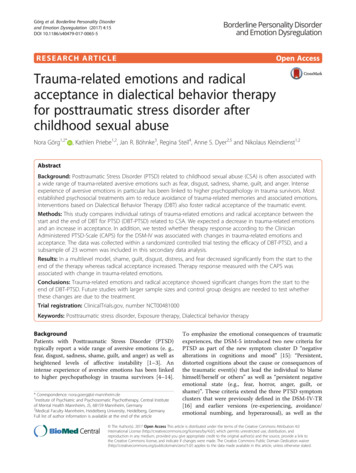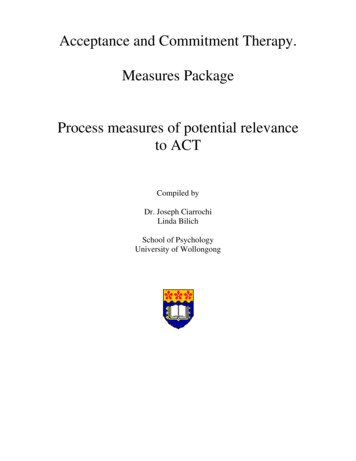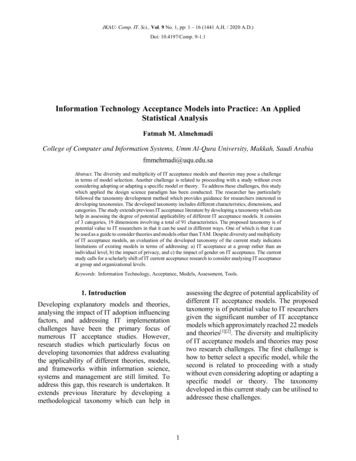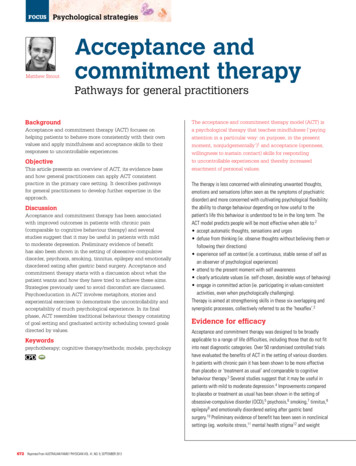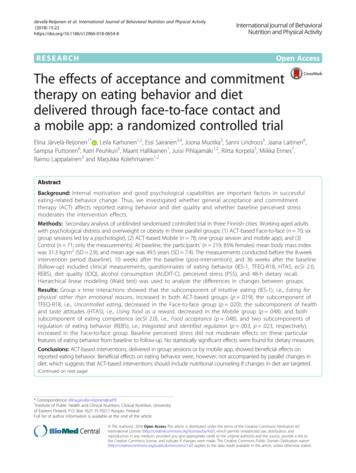
Transcription
Järvelä-Reijonen et al. International Journal of Behavioral Nutrition and Physical Activity(2018) ARCHOpen AccessThe effects of acceptance and commitmenttherapy on eating behavior and dietdelivered through face-to-face contact anda mobile app: a randomized controlled trialElina Järvelä-Reijonen1* , Leila Karhunen1,2, Essi Sairanen3,4, Joona Muotka3, Sanni Lindroos5, Jaana Laitinen6,Sampsa Puttonen6, Katri Peuhkuri5, Maarit Hallikainen1, Jussi Pihlajamäki1,2, Riitta Korpela5, Miikka Ermes7,Raimo Lappalainen3 and Marjukka Kolehmainen1,2AbstractBackground: Internal motivation and good psychological capabilities are important factors in successfuleating-related behavior change. Thus, we investigated whether general acceptance and commitmenttherapy (ACT) affects reported eating behavior and diet quality and whether baseline perceived stressmoderates the intervention effects.Methods: Secondary analysis of unblinded randomized controlled trial in three Finnish cities. Working-aged adultswith psychological distress and overweight or obesity in three parallel groups: (1) ACT-based Face-to-face (n 70; sixgroup sessions led by a psychologist), (2) ACT-based Mobile (n 78; one group session and mobile app), and (3)Control (n 71; only the measurements). At baseline, the participants’ (n 219, 85% females) mean body mass indexwas 31.3 kg/m2 (SD 2.9), and mean age was 49.5 years (SD 7.4). The measurements conducted before the 8-weekintervention period (baseline), 10 weeks after the baseline (post-intervention), and 36 weeks after the baseline(follow-up) included clinical measurements, questionnaires of eating behavior (IES-1, TFEQ-R18, HTAS, ecSI 2.0,REBS), diet quality (IDQ), alcohol consumption (AUDIT-C), perceived stress (PSS), and 48-h dietary recall.Hierarchical linear modeling (Wald test) was used to analyze the differences in changes between groups.Results: Group x time interactions showed that the subcomponent of intuitive eating (IES-1), i.e., Eating forphysical rather than emotional reasons, increased in both ACT-based groups (p .019); the subcomponent ofTFEQ-R18, i.e., Uncontrolled eating, decreased in the Face-to-face group (p .020); the subcomponent of healthand taste attitudes (HTAS), i.e., Using food as a reward, decreased in the Mobile group (p .048); and bothsubcomponent of eating competence (ecSI 2.0), i.e., Food acceptance (p .048), and two subcomponents ofregulation of eating behavior (REBS), i.e., Integrated and Identified regulation (p .003, p .023, respectively),increased in the Face-to-face group. Baseline perceived stress did not moderate effects on these particularfeatures of eating behavior from baseline to follow-up. No statistically significant effects were found for dietary measures.Conclusions: ACT-based interventions, delivered in group sessions or by mobile app, showed beneficial effects onreported eating behavior. Beneficial effects on eating behavior were, however, not accompanied by parallel changes indiet, which suggests that ACT-based interventions should include nutritional counseling if changes in diet are targeted.(Continued on next page)* Correspondence: elina.jarvela-reijonen@uef.fi1Institute of Public Health and Clinical Nutrition, Clinical Nutrition, Universityof Eastern Finland, P.O. Box 1627, FI-70211 Kuopio, FinlandFull list of author information is available at the end of the article The Author(s). 2018 Open Access This article is distributed under the terms of the Creative Commons Attribution 4.0International License (http://creativecommons.org/licenses/by/4.0/), which permits unrestricted use, distribution, andreproduction in any medium, provided you give appropriate credit to the original author(s) and the source, provide a link tothe Creative Commons license, and indicate if changes were made. The Creative Commons Public Domain Dedication o/1.0/) applies to the data made available in this article, unless otherwise stated.
Järvelä-Reijonen et al. International Journal of Behavioral Nutrition and Physical Activity (2018) 15:22Page 2 of 14(Continued from previous page)Trial registration: ClinicalTrials.gov (NCT01738256), registered 17 August, 2012.Keywords: ACT, Behavior change, Mindfulness, Mindful eating, Intuitive eating, Dietary intake, Regulation of eatingbehavior, Overweight, Obesity, mHealthBackgroundMaking long-term eating-related behavioral changes topromote health is difficult. We need to find ways to support people in making the changes [1]. Long-termchanges seem to be associated, for example, with supporting individual’s autonomy and internal motivation[2]. Internal motivation for regulating eating means thatone is engaged in health-related behavior for one’s ownsake and free will and that one’s action is congruent withown values and goals [3].Acceptance and commitment therapy (ACT) is onepromising method in changing behavior towards a person’s own values and goals. ACT consists of six interrelated core processes: (1) clarification of own values, (2)commitment to act based on those values, (3) being incontact with the present moment (i.e., mindfulness), (4)having self as context (i.e., being aware of thoughts, feelings, etc. without attaching to them), (5) defusion (i.e.,altering the way to interact with or relate to thoughts,feelings, etc.), and (6) acceptance [4]. Thus, ACT aims tostrengthen positive psychological processes related tocommitment, behavior change, mindfulness, and acceptance [4], which can be applied to promote healthy behavioral patterns [5]. Using ACT is supported by thepromising results of ACT-based interventions on foodcravings [6] and weight loss [7–13].Furthermore, deficiency of one of the core processesof ACT, namely, mindfulness, during eating can lead toovereating or eating without physical hunger [14, 15].Mindfulness training, instead, has reduced impulsive eating and binge eating in adults with overweight and obesity [16], has reduced energy intake in experimentalsettings [17, 18], and may thus increase consciousness ofone’s eating behavior and its regulation.One aim in mindful eating training is to increaseawareness of bodily hunger and satiety cues and to eataccording to them [19, 20]. The emphasis on bodilyhunger and satiety cues is also included in two conceptsof eating behavior: intuitive eating (i.e., having unconditional permission to eat whatever desired, and eatingrelying on hunger and satiety cues and not on emotions)[21, 22] and eating competence (i.e., having positive attitudes about eating and food, accepting and eating anever-increasing variety of foods, eating according to internal hunger and satiety signals, and having skills andresources for managing daily meals) [23]. Both intuitiveeating and eating competence have been associated withbetter diet quality [24, 25] and lower BMI [22, 26–28].However, no previous ACT or mindfulness interventionstudies have been targeted on eating competence, andthose reporting effects on intuitive eating have hadstrong emphasis on intuitive eating approach in theintervention [29, 30]. Previous mindfulness-based interventions have been shown to decrease [31, 32] or tohave no effect [9, 33] on emotional eating (i.e., eatingbased on negative emotions [34]). Thus, more researchon the effects of ACT and mindfulness on eating behavior is needed.There is also a need for new methods that are costeffective to health care systems and easily accessible tothe people who need support. New technology, such asmobile apps, have gained wide interest recently [35–38],and there is already some evidence that mobile apps canbe effective in improving health-related behavior [39].The aim of this study was to investigate the effects ofACT intervention delivered in two different ways, i.e.,via face-to-face group sessions and via mobile app, onreported eating behavior and diet quality among adultswith psychological distress and overweight or obesity.Because there is some evidence that human support enhances technology-based interventions’ effects [40–42],we hypothesized that the effects of an independentlyused mobile app ACT would be more modest than theeffects of face-to-face ACT. The ACT intervention wasnot designed to specifically target eating behavior. However, several hypothesized effects are presented in Fig. 1.We found previously in this study population [43] thathigher perceived stress is associated with unfavorablefeatures of eating behavior: having less intuitive eating,eating competence and cognitive restraint, and more uncontrolled and emotional eating. Therefore, we also investigated whether baseline perceived stress moderatesthe effects of ACT on eating behavior.MethodsStudy designThe present study is a secondary analysis of the parallelarm Elixir randomized controlled trial in which threedifferent psychological interventions were studied [44].The present study focuses on the effects of the twointervention arms based on ACT. See Lappalainen et al.[44] for the study protocol and participant flow chart.The study participants were recruited by advertisements in local newspapers and screened for eligibility via
Järvelä-Reijonen et al. International Journal of Behavioral Nutrition and Physical Activity (2018) 15:22Page 3 of 14Fig. 1 Theoretical model. The hypothesized effects of the core processes of Acceptance and Commitment Therapy (ACT) on the reported features ofeating behaviortelephone and on-line questionnaire from August 2012until January 2013. The participants had to be 25–60 years old and have a self-reported body mass index(BMI) 27–34.9 kg/m2. The participants also had to bepsychologically distressed ( 3/12 points from the General Health Questionnaire, GHQ-12 [45]) and have computer and Internet access. There were several exclusioncriteria, such as diagnosed severe chronic illness including eating disorder, disabilities/illnesses affecting substantially physiological or mental health, pregnancy orbreastfeeding within the past 6 months, psychotherapyor other psychological or mental treatment at least twicea month, and participation in other intervention studiesduring the present study. The multicenter study wasconducted in three cities in Finland (Jyväskylä, Kuopio,and Helsinki) in two phases. The first phase started inautumn and the second phase in spring. The participantsfilled in electronic questionnaires, visited the local studycenter for clinical and biochemical measurements, andreported their food consumption in a 48-h dietary recallby telephone. Measurements were conducted before theintervention (baseline, study week 00), after the 8-weekintensive intervention period (post-intervention, studyweek 10), and 36 weeks after baseline measurements(follow-up, study week 36). The measurements were collected from August 2012 until December 2013.The sample size of the current study is based on thepower calculation (for depression symptoms) of theElixir randomized controlled trial [44], resulting a sample size of n 80–85 per group.Ethics, consent and permissionsThe study was approved by the ethics committee ofthe Central Finland Health Care District (referencenumber 7 U/2012) and was performed in accordancewith the Declaration of Helsinki. The participantsgave their written informed consent before participating. The study was registered with ClinicalTrials.govwith the identifier NCT01738256.ParticipantsOf the 254 individuals randomized to the Face-to-face,Mobile or Control groups, 219 participated in baselinemeasurements. At baseline, the participants’ (n 219,85% females) mean BMI was 31.3 kg/m2 (SD 2.9), andtheir mean age was 49.5 years (SD 7.4). The baselinedemographic and clinical characteristics did not differamong the three study groups (Table 1). The number ofparticipants at baseline, post-intervention, and follow-upwere as follows: Face-to-face group—70, 62, and 60; Mobile group—78, 75, and 73; and Control group—71, 68,and 67, respectively. Thus, 89%, 96% and 96% of theFace-to-face, Mobile and Control group participantscompleted the post-intervention measurements, and86%, 94% and 94% completed the follow-up measurements, respectively.Study groupsThe Face-to-face and Mobile interventions were basedon the same ACT program constructed by the same research group. Thus, only the delivery method of theintervention differed. The two interventions includedthe following main components: value clarification, acting according to own values, mindfulness skills, the observing self (e.g., observing thoughts without beingcaught up in them), and acceptance skills (e.g., makingroom for unpleasant feelings and urges allowing them tocome and go). The main focus was on ACT skills but
Järvelä-Reijonen et al. International Journal of Behavioral Nutrition and Physical Activity (2018) 15:22Page 4 of 14Table 1 Baseline demographic and clinical characteristics of each groupNumber of participants (n)Face-to-faceMobileControl707871Starting time of the study (n).642Autumn353730Spring354141202217Study center le616658MaleGender (n).67091213Age (years)50.3 7.249.1 7.749.2 7.4.575Weight (kg)86.1 10.388.4 10.488.3 11.5.342BMI (kg/m2)31.0 3.131.6 2.731.2 2.8.423Psychological distress (GHQ-12 score)7.2 3.06.8 2.87.4 2.7.408bPerceived stress (PSS score)25.8 8.026.9 7.826.9 7.6.597Values are n / mean SD; Autumn September – October 2012; Spring January – February 2013; BMI body mass index, GHQ-12 General Health Questionnaire-12,PSS Perceived Stress Scaleap-value for differences between the study groups (Pearson chi-square for categorical variables and one-way ANOVA for continuous variables unless other noted)bNon-parametric Kruskal-Wallis testminor parts of mindful eating, relaxation, and everydayphysical activity were also included. Mindful eating wasthe topic of one group session in the Face-to-face intervention group and of one section in the Mobile group’sapp. The mindful eating component of the interventionconsisted of learning to be present while eating; observeeating-related thoughts and feelings; observe and trusthunger and satiety cues; notice challenges for eatingbased on physical cues; be aware of the effects of noteating mindfully; recognize individual needs and feelingsrelated to meal rhythm; and practicing mindful groceryshopping. Intervention did not include nutrition education. Only a hyperlink to a public nutritional web sitewas provided to the participants in intervention groups,which was to be utilized if the dietary changes were according to one’s values. See Lappalainen et al. [44] for amore detailed description of the intervention.The Face-to-face group had six group sessions led by apsychologist during the 8-week intervention period.Each session took approximately 90 min, and each groupconsisted of 6–12 participants. The sessions included exercises, pair and group discussions, and homework forwhich the participants received a workbook.The mobile group had one group session in which participants learned of the principles of ACT and receivedsmartphones with the pre-installed Oiva mobile app[46]. The Oiva app contains 46 exercises in text andaudio formats and introduction videos about the ACTskills. The user experience results of the app werepositive [46]. The participants were free to chooseexercises and videos in any order and to do them asmany times as the participants wanted during the 8week intervention period. The participants returned thesmartphones during the post-intervention laboratorystudy visit. The participants’ usage of the mobile app isreported in detail by Mattila et al. [47].Participants randomized to the Control group participated in all of the measurements and did not receive anyintervention. After the follow-up measurements, the participants in the Control group had an opportunity toattend one group session in which principles of ACTwere presented and to utilize the Internet-based lifestylecoaching program.MeasuresBackground characteristicsWeight and height were measured with calibrated instruments at each study center in the morning after a12-h overnight fast [44]. BMI was calculated from themeasured weight and height as kilograms per meterssquared. The demographic information was collectedusing a questionnaire. The 12-item General HealthQuestionnaire, GHQ-12 [45], was used to screen thevolunteers for psychological distress. The GHQ-12 hasbeen found to be a valid screening tool for commonmental health problems in the Finnish population [48].The respondents were asked, considering the past fewweeks, to answer questions such as “Have you recently
Järvelä-Reijonen et al. International Journal of Behavioral Nutrition and Physical Activity (2018) 15:22felt capable of making decisions about things?” Bimodalscoring was used: “not at all” (0 points); “same as usual”(0); “rather more than usual” (1); and “much more thanusual” (1), with the total sum score ranging from 0 to12. Cronbach’s alpha was 0.72.Outcome measuresEating behavior The Intuitive Eating Scale, IES [22],consists of 21 items with subcategories of intuitive eating: (a) Unconditional Permission to Eat (9 items, e.g.,“If I am craving a certain food, I allow myself to haveit.”), (b) Eating for Physical Rather Than Emotional Reasons (6 items, e.g., reversely scored “I find myself eatingwhen I am bored, even when I’m not physically hungry.”), and (c) Reliance on Internal Hunger/Satiety Cues(6 items, e.g., “I trust my body to tell me when to eat.”).The statements are answered with a 5-point Likert scale.The scores are averaged; thus, the possible ranges of theIES total score and its subscales are 1–5. Cronbach’salpha at baseline was 0.79 for the entire scale and 0.66,0.84, and 0.77 for the subscales Unconditional Permission to Eat, Eating for Physical Rather Than EmotionalReasons, and Reliance on Internal Hunger/Satiety Cues,respectively. The questionnaire had been validatedamong college women in the USA [22].The Three-Factor Eating Questionnaire, TFEQ-R18[34], was used to measure (a) Cognitive Restraint (6items, e.g., “I deliberately take small helpings as a meansof controlling my weight.”), (b) Uncontrolled Eating (9items, e.g., “Sometimes when I start eating, I just can’tseem to stop.”), and (c) Emotional Eating (3 items, e.g.,“When I feel blue, I often overeat.”). The answers aregiven by 4-point Likert scale, except for one item, whichis answered using an 8-point Likert scale. The possiblerange of the total scores was 0–100. Cronbach’s alphaswere 0.71, 0.88, and 0.89 for the scales CognitiveRestraint, Uncontrolled Eating, and Emotional Eating,respectively. The Finnish version of the questionnairehad been validated in young, mostly normal weight,females and showed good structural validity [49].Of the Health and Taste Attitude Scales, HTAS [50],subcategories (a) Pleasure (6 items, e.g., “When I eat, Iconcentrate on enjoying the taste of food.”) and (b) UsingFood as a Reward (6 items, e.g., “I reward myself by buying something really tasty.”) were used. The statementswere answered using a 7-point Likert scale. The scoreswere averaged; thus, the possible ranges were 1–7. Cronbach’s alphas were 0.71 and 0.81 for the subcategoriesPleasure and Using Food as a Reward, respectively. Thequestionnaire developed in Finland had been validatedamong several general Finnish adult samples [50–52].Eating competence was measured using a preliminaryFinnish translation of ecSatter Inventory 2.0, ecSI 2.0 [28,53, 54]. The definition of eating competence consisted ofPage 5 of 14four components, which also constituted the 16-itemquestionnaire’s subcategories: (a) Eating Attitudes (5items, e.g., “I am relaxed about eating.”), (b) Food Acceptance (3 items, e.g., “I experiment with new food and learnto like it.”), (c) Internal Regulation (3 items, e.g., “I eat asmuch as I am hungry for.”), and (d) Contextual Skills (5items, e.g., “I generally plan for feeding myself. I don’t justgrab food when I get hungry.”). The statements wereanswered: “always” (3 points), “often” (2), “sometimes” (1),“rarely” (0), or “never” (0). The possible ranges of the sumscores were as follows: Eating Competence total score, 0–48; Eating Attitudes and Contextual Skills, 0–15, and FoodAcceptance and Internal Regulation, 0–9. Cronbach’salpha was 0.76 for the whole scale and 0.58, 0.68, 0.59,and 0.75 for the subscales Eating Attitudes, Food Acceptance, Internal Regulation, and Contextual Skills, respectively. The questionnaire had been validated among mostlyfemale, overweight and educated adult sample [26], lowincome females [28, 53] and parents of preschool-agechildren [54] in the USA.The motivation for eating behavior regulation wasmeasured using the 24-item Regulation of Eating Behavior Scale, REBS [3]. The participants were asked toanswer the question “Why are you regulating your eatingbehaviors?” with a 7-point scale ranging from “Does notcorrespond at all” (1) to “Corresponds exactly” (7). Thescale measured autonomous forms of motivation: (a)Intrinsic motivation (e.g., “It is fun to create meals thatare good for my health”), (b) Integrated regulation (e.g.,“Eating healthy is an integral part of my life”), and (c)Identified regulation (e.g., “It is a good idea to try toregulate my eating behaviors”). In addition, there werecontrolled forms of motivation: (d) Introjected regulation (e.g., “I don’t want to be ashamed of how I look.”),(e) External regulation (e.g., “People around me nag meto do it.”), and (f ) Amotivation (e.g., “I can’t really seewhat I’m getting out of it.”). Each category (a–f ) included four items. The scores were averaged; thus, thepossible ranges were 1–7. Cronbach’s alphas were 0.86,0.89, 0.75, 0.60, 0.89, and 0.71 for a, b, c, d, e, and f,respectively. The questionnaire had been validatedamong female university students in Canada [3]. TheFinnish version used in this study had been pilot-testedamong a general adult sample (n 37).Food consumption and nutrient intake A concisemeasure of food consumption, the Index of Diet Quality(IDQ) [55], consisted of 18 questions about frequency,portion size, and/or type of certain foods and drinksconsumed during the previous month to evaluateadherence to Nordic and Finnish nutrition recommendations. The questions involved whole-grain products,fat-containing foods, liquid dairy products, vegetables,fruits and berries, sugary products, and the regularity of
Järvelä-Reijonen et al. International Journal of Behavioral Nutrition and Physical Activity (2018) 15:22meal pattern. The answers were scored as either reflecting health-promoting diet (1 point) or not (0 points).Part of the questions (regarding both frequency and portion of the food or drink) were combined for the scoring,and thus the possible IDQ total score was 0–15. Pointsbelow 10 indicated non-adherence, and points from 10 to15 indicated adherence to the health-promoting diet [55].In this study, answers that seemed possibly unrealistic oroutliers (e.g., 27 slices of bread per day) were confirmedwith the participant, and corrections were made whenneeded. Answers that remained unverified (n 1 at baseline, n 2 at post-intervention) were coded as missing.The IDQ had been developed and validated amongFinnish healthy, mostly normal weight, adult femalesusing a seven-day food record [55].Alcohol consumption during the previous six monthswas measured using the Finnish version of the questionnaire Alcohol Use Disorders Identification Test Consumption, AUDIT-C [56]. This questionnaire had beenshown to have strong correlation to alcohol consumption in a general Finnish population [57]. The questionnaire contained three questions regarding the frequencyand amounts of alcohol usage. For the questions concerning the amount of drinks consumed, a list of typicalFinnish serving sizes and their corresponding amountsas standard drinks (e.g., 33 cl bottle of beer is one drink)were provided. The responses were scored from 0 to 4and summed, and the possible total score was from 0 to12. Cronbach’s alpha was 0.66.The 48-h dietary recall was conducted to collect information on nutrient intake. The participants were askedto describe all of the foods and drinks consumed duringthe previous full 48 h (beginning at midnight and endingat midnight over two consecutive 24 h periods). Theinterview was conducted by trained nutritionists by telephone at a pre-scheduled time. The participants weretold that the interview considered diet, but anything regarding 48-h recall was not mentioned beforehand. Anelectronic picture book [58] was used to help to describeportion sizes. The interviews were performed fromTuesday to Friday. The nutrient intake was calculatedusing AivoDiet software version 2.0.2.2 (Aivo Ltd.,Turku, Finland) and the Fineli Finnish Food Composition Database (National Institute for Health andWelfare, Nutrition Unit, Helsinki, Finland). The interview protocol of the 48-h dietary recall was createdbased on the face-to-face 48-h dietary recall conductedin the national FINDIET 2012 survey [59]. The 48-hdietary recall protocol of the Elixir study was designedby the three nutritionists who also conducted the interviews. The participants were encouraged to be truthfulin the 48-h dietary recall and were told that the interviewer would not assess or comment on their eating anddrinking or give any dietary counseling. The foods andPage 6 of 14beverages consumed during the 48 h were repeated atthe end, and the interviewer encouraged the participantto make additions or modifications while repeating thecourse of the days’ events.ModeratorPerceived stress The Perceived Stress Scale, PSS [60], isa 14-item measure for assessing the degree to which aperson perceives life as stressful. The questionnaire hasdemonstrated acceptable psychometric properties worldwide [61]. Questions concern how often a person has experienced certain feelings and thoughts during theprevious month, e.g., “In the last month, how often haveyou found that you could not cope with all the thingsthat you had to do?” The 5-point Likert scale from“never” (0) to “very often” (4) is summed for the totalscore (possible range 0–56). Cronbach’s alpha was 0.88.Statistical methodsThe statistical analyses were performed using IBMSPSS Statistics version 21 and Mplus version 7.3.Pearson chi-square test, one-way ANOVA, and theKruskal-Wallis test were used to test whether baselinedemographic and clinical characteristics differed between the study groups.Hierarchical linear modeling (HLM, Wald test) wasused to analyze the group x time interaction, i.e., whetherthe three study groups changed differently between themeasured time points (study weeks 00, 10, and 36). Ifthere was a difference, post hoc tests were conducted todetermine between the three study groups whether thedifference was during the intensive intervention period(from study week 00 to 10) or after the intensive intervention period (from study week 10 to 36). HLM accounts formissing values at random (MAR) and includes all of theavailable data. The parameters were estimated using thefull-information maximum likelihood method (MLR estimation in Mplus). The analyses were adjusted for studycenter and starting time of the study. Emotional eating,External regulation, and intake of monounsaturated fat(E%) differed significantly between the groups at baseline,and these analyses were conducted also adjusting for thebaseline value. Exact p-values of Wald tests areshown in Table 2 and Additional file 1, whereas statistically significant p-values of the post hoc analysesare presented in the text.Cohen’s d was calculated from baseline to follow-up(Δ 36 weeks) within- and corrected between-groups toestimate effect sizes using the estimated values. Awithin-group effect size of 0.5 is considered small, 0.8medium, and 1.1 large, and a corrected between-groupeffect size of 0.2 is considered small, 0.5 medium, and0.8 large [62].
2.4 0.83.2 0.6Eating for Physical Rather Than EmotionalReasonsReliance on Internal Hunger/Satiety Cues3.3 0.62.6 0.83.1 0.63.0 0.410 wk3.4 0.62.7 0.83.1 0.73.1 0.536 wk0.290.443.2 0.62.6 0.83.4 0.62.7 0.83.1 0.63.0 0.536 wk.090pa0.270.100.11 0.050.270.13db10.0 2.14.9 2.04.7 1.96.7 3.1Eating AttitudesFood AcceptanceInternal RegulationContextual Skills5.1 1.23.9 1.35.8 0.94.2 1.1Intrinsic motivationIntegrated regulationIdentified regulationIntrojected regulationREBS26.2 6.04.3 1.2Using Food as a RewardecSI 2.0 total score4.7 0.9PleasureHTAS4.0 1.26.0 0.84.5 1.35.3 1.27.3 3.14.8 1.84.9 1.99.7 2.126.6 6.34.2 1.24.8 0.84.0 1.26.0 0.84.7 1.45.4 1.27.6 3.15.1 1.75.5 1.610.0 2.528.1 6.64.0 1.24.8 0.94.0 1.2 0.13 4.2 1.24.4 1.15.2 1.26.8 3.05.1 1.65.7 1.04.3 1.35.1 1.36.5 3.05.0 1.65.1 2.05.9 0.90.170.550.190.240.225.2 1.99.8 1.9 0.03 9.7 2.20.2526.8 6.226.3 5.74.2 1.2 0.21 4.6 1.10.224.8 0.94.9 1.00.164.1 1.35.7 0.94.3 1.45.2 1.47.1 3.24.7 1.85.0 2.09.4 2.426.2 6.24.1 1.24.7 1.0 0.09 4.3 1.24.1 1.25.6 1.1 0.20 5.7 0.94.9 1.34.0 1.34.9 1.44.1 1.30.090.056.4 2.65.0 1.5 0.17 4.8 1.86.4 3.14.9 1.9 0.09 4.9 1.80.189.5 2.625.8 5.9 0.04 25.8 6.4 0.12 9.7 2.64.2 1.14.7 1.1 0.39 4.3 1.2 0.16 4.7 1.04.1 1.35.7 0.94.2 1.45.0 1.47.1 2.94.9 1.84.8 1.99.7 2.226.5 6.44.2 1.24.8 1.0.066 0.01 0.30.1640.00 0.090.14 0.110.09 0.040.05 0.020.20 0.180.08.023 0.15 0.21.003 0.41 0.04.831.720.077 0.19 .9550.020.120.090.200.02 0.04 .048 0.31 0.06 0.03 .1440.07 0.10 .048 0.11 0.290.1564.9 25.3 57.3 24.6 54.6 25.6 0.40 62.4 27.5 56.3 26.0 52.8 25.8 0.36 55.9 27.9 54.4 28.9 53.8 25.1 0.08 .083d 0.31 0.270.370.150.04 0.01Emotional Eating.252.967.019 0.400.33 0.01 .2770.16dc45.8 15.3 48.4 15.3 47.7 16.2 0.113.2 0.7
Acceptance and commitment therapy (ACT) is one promising method in changing behavior towards a per-son's own values and goals. ACT consists of six interre-lated core processes: (1) clarification of own values, (2) commitment to act based on those values, (3) being in contact with the present moment (i.e., mindfulness), (4)


